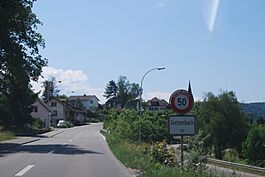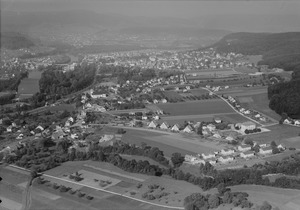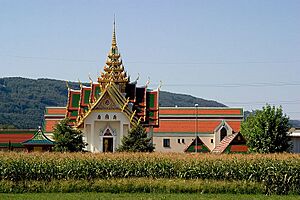Gretzenbach facts for kids
Quick facts for kids
Gretzenbach
|
||
|---|---|---|
 |
||
|
||
| Country | Switzerland | |
| Canton | Solothurn | |
| District | Olten | |
| Area | ||
| • Total | 5.83 km2 (2.25 sq mi) | |
| Elevation | 398 m (1,306 ft) | |
| Population
(Dec 2020 )
|
||
| • Total | 2,772 | |
| • Density | 475.5/km2 (1,231.5/sq mi) | |
| Postal code |
514
|
|
| Surrounded by | Däniken, Kölliken (AG), Niedergösgen, Oberentfelden (AG), Safenwil (AG), Schönenwerd, Walterswil | |
Gretzenbach is a small town, also called a municipality, in Switzerland. It's located in the Olten district within the canton of Solothurn.
Contents
History of Gretzenbach
Gretzenbach was first mentioned in old records way back in the year 778! However, the oldest document we have that mentions it is a copy from the 10th century. Later, in 1265, it was called Grezenbach.
A big change happened on January 1, 1973. On this date, a nearby village called Grod joined with Gretzenbach. They became one larger municipality.
Geography of Gretzenbach
Gretzenbach covers an area of about 5.8 square kilometers (that's about 2.2 square miles). A large part of this land, about 41.9%, is used for farming. Forests cover another big part, about 36.4% of the area.
About 21% of Gretzenbach is covered by buildings and roads. A small amount, less than 1%, is made up of rivers or lakes.
The town is located on a raised area of land. The Aare river has carved out several channels nearby. Gretzenbach includes the main village, a settlement called Weid, and the area of Grod, which joined in 1973.
Gretzenbach's Coat of Arms
A coat of arms is like a special symbol for a town or family. Gretzenbach's coat of arms shows a green fir tree. The tree stands on three green hills. The background behind the tree is silver.
People and Population
Gretzenbach has a population of about 2,600 people. Most people in Gretzenbach speak German, which is about 92.1% of the population. Italian is the second most common language, spoken by about 3% of the people.
In 2000, about 30% of the people living in Gretzenbach were born there. About 21.7% were born in the same canton (Solothurn). Many others, about 32.8%, were born somewhere else in Switzerland. About 13.3% of the people were born outside of Switzerland.
Age Groups in Gretzenbach
In 2000, the population of Gretzenbach included:
- Children aged 0 to 6 years old: about 9.5%
- Teenagers aged 7 to 19 years old: about 19.4%
- Young adults aged 20 to 24 years old: about 4.8%
- Adults aged 25 to 44 years old: about 32.8%
- Adults aged 45 to 64 years old: about 22.6%
- Seniors aged 65 to 79 years old: about 8.3%
- Seniors over 80 years old: about 2.5%
Homes in Gretzenbach
In 2000, there were 887 private homes in Gretzenbach. On average, about 2.7 people lived in each home. About 23.6% of homes had only one person living in them. There were also many homes with married couples, some with children and some without.
Most of the buildings in Gretzenbach are single-family homes. In 2000, about 77.5% of all inhabited buildings were single-family homes.
The historical population of Gretzenbach has changed over time, as shown in this chart:

Economy in Gretzenbach
In 2010, the unemployment rate in Gretzenbach was 3.2%. This means a small number of people who wanted jobs couldn't find them.
The economy is divided into three main parts:
- Primary sector: This includes jobs like farming. In 2008, about 29 people worked in this area.
- Secondary sector: This includes jobs in factories and construction. About 436 people worked in this sector.
- Tertiary sector: This includes jobs that provide services, like shops, restaurants, and schools. About 239 people worked in this sector.
Many people who live in Gretzenbach travel to other towns for work. In 2000, about 1,042 workers left Gretzenbach for their jobs, while 371 workers came into Gretzenbach for work. Most people, about 61.4%, used a private car to get to work. About 17.5% used public transportation.
Religion in Gretzenbach
Based on a 2000 survey:
- About 42.1% of the people were Roman Catholic.
- About 33.4% belonged to the Swiss Reformed Church.
- A smaller number of people belonged to other Christian churches, or were Islamic, Buddhist, or Hindu.
- About 12.75% of the population said they didn't belong to any church or were agnostic or atheist.
Gretzenbach is home to the Wat Srinagarindravararam, which is a Buddhist temple. It was named in honor of Princess Srinagarindra, who was the mother of the King of Thailand, Rama IX. She gave her special permission for the temple to use her name.
Education in Gretzenbach
In Gretzenbach, many adults have completed a good level of education. About 38.5% of the population has finished upper secondary education (like high school). About 11.9% have gone on to even higher education, such as university.
The school system in Solothurn canton works like this:
- Young children can go to two years of Kindergarten, which is not required. In 2010-2011, there were 48 children in kindergarten in Gretzenbach.
- Students then go to six years of primary school. In Gretzenbach, there were 155 students in primary school.
- After primary school, students go to secondary school. All secondary students from Gretzenbach attend their school in a nearby town.
See also
 In Spanish: Gretzenbach para niños
In Spanish: Gretzenbach para niños






